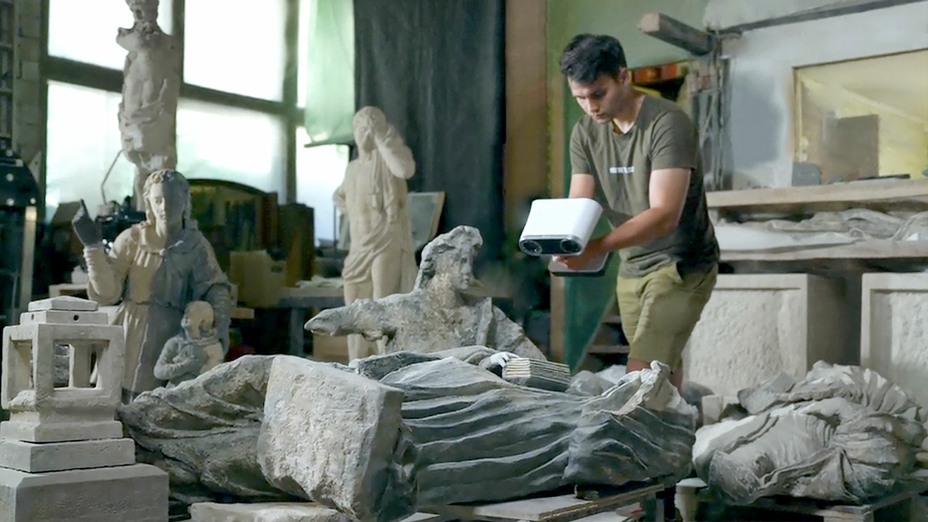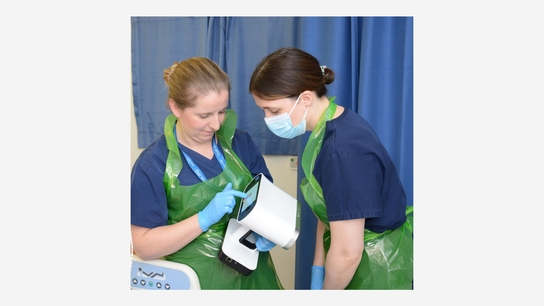Artec 3D steps up in effort to preserve Ukraine’s cultural heritage
Challenge: As the tanks roll over, the people of Ukraine are fiercely protecting the cultural heritage of their country, among many pressing needs. In the face of this war, the Lviv-based initiative Skeiron has committed themselves to digitizing cultural landmarks for archiving, restoration, and making unique Ukrainian heritage digitally accessible worldwide.
Solutions: Artec Leo, Artec Studio
Result: After launching #SaveUkrainianHeritage to save architectural monuments at risk, Skeiron, with the support of Artec 3D, initiated “Museum in 3D”. Now featured on Google Arts and Culture, the project boasts more than 200 museum artifacts scanned with Artec Leo, which can all be accessed and viewed online.
Why Artec: A global leader in 3D scanning tech, Artec 3D is using its commitment to help, along with its cutting-edge tools, to contribute towards conserving Ukrainian identity through preserving its heritage. High-quality 3D scans with photorealistic texture made with Artec 3D technology continue to create a precedent in terms of protecting cultural artifacts in wartime.
Attempting to save cultural identity
Ongoing aggression in Ukraine has caused unspeakable damage to the country’s people and infrastructure, and its heritage has not been spared either. In addition to the human toll of the war, Ukrainian cultural institutions, architectural beauties, and historical sites are destroyed daily, or remain at constant risk. According to the report of the Council of Europe, Ukraine has more than 140,000 monuments and objects of immovable cultural heritage, with more than a half of them being archaeological and historical monuments. In addition, there are rare monuments of landscape architecture, science, and engineering.

According to the Council of Europe, Ukraine has more than 140,000 objects of cultural heritage
Many civilians felt they needed a way to save the landmarks reflecting their identity. Keeping these treasures behind scaffolding or sandbag shields was just the start – one quintessential aspect of national heritage conservation is its popularization, creating a positive and attractive image of the country across the globe. Since the eruption of the war, Artec 3D and its partners in Ukraine have rushed to protect churches, museums, libraries, monuments, and paintings as they continue to suffer irreversible damage. To make Ukrainian traditions and culture undeletable, Artec 3D is supporting its partners by providing scanners and software, as well as giving visibility to their crucial work.
One such partner is Skeiron, a team from the multicultural, UNESCO-listed Lviv. The initiative is best known for kick-starting the #SaveUkrainianHeritage project, aiming to capture as many architectural monuments at risk as possible. Established back in 2016, the tech quickly grew from a start-up to a company specializing in a wide range of scanning and geodesy services. One of the very first to offer high-quality 3D digitization in Ukraine, the team at Skeiron has worked with public sector companies, businesses, NGOs, and state cultural institutions.

Skeiron evolved from a team of friends to an innovative 3D digitization company. Image source: Skeiron / Facebook
From a school friends start-up to a revolutionary tech company
The ground-breaking project started with the three school friends feeling passionate about 3D. “We all wanted to do work with this technology,” said Skeiron’s Andriy Hryvnyak. “Yury studied surveying and geodesy, I studied computer engineering, and Volodya was engaged in computer science, so each of us saw it from a different perspective. We have always been engaged in different 3D services, but we decided that we should start doing something for ourselves, in which we see development.”

Skeiron’s Andriy Hryvnyak scanning with Artec Leo
In 2022, upon the full-blown invasion of Ukraine, the team also initiated “Museum in 3D” in which they made full use of Artec 3D’s flagship scanner Artec Leo. Having been deeply concerned about the fate of Ukraine’s cultural sites for years, it was only natural that the war prompted a new calling to digitally secure architectural and artistic heritage. Artec Leo, the wireless 3D scanning device with a revolutionary HD screen and on-board processing, became a new tool in Skeiron’s arsenal. “We used the Artec 3D scanner for this project, because it allowed us to create models in great color and upload them onto the platform,” Hryvnyak said. “Artec 3D also partially funded this project, which allowed us to use more of the budget in other areas.”

“Museum in 3D” made more than 200 museum artifacts digitally accessible all across the globe
The project holds a special place among the team: With their unparalleled expertise in photogrammetry and laser scanning, they have had to quickly regroup and adapt since the onset of the war. Some of the founders and team members were stationed on the front lines, leaving their remaining colleagues keeping things running while doing their best not to lose motivation or hope in their project.
This drive and persistence paid off: Not only has Skeiron stayed fully functional since February 2022, they have also started training new specialists, developing new skills, and testing new technologies.
Getting to know the Artec Leo
The team got some initial guidance from Artec 3D’s long-trusted Ukrainian partners, KODA Ltd, and their 3D scanning expert Oleksandr Skiba. Upon a short introduction on scanning and processing with Leo, the specialists at Skeiron had the scanner all to themselves to test and explore. The first impressions were immediately encouraging: “We've used photogrammetry before: it is a longer process to capture data for a 3D model and get this geometry. With Leo, I immediately see the model on the screen, and during processing I get much more precise geometry – the contours of the object are more precise as well. This scanner immediately gives an accurate model, in millimeters, at the output, which can be used for restoration works. If I used pure photogrammetry, I'd still have to tie it to certain dimensions. But in Leo everything is there by default.”

The 3D replica of an object being built in real time on Leo’s screen
Skeiron found scanning with Leo liberating. “The shooting process is very simple because you see everything on the screen, you only need to understand the frequency of the scanning frames, and you may need to conduct several preliminary shootings to tune in. We have already found our optimal settings for scanning such objects,” Hryvnyak shared.
Being part of Google Arts and Culture, “Museum in 3D” features more than 200 Ukrainian museum artifacts scanned with the Artec Leo, all available to admire online in every beautiful detail. A significant portion of artifacts come from the Lviv Historical Museum, but the team has the entire list of objects to be scanned in different parts of Ukraine, and is looking forward to working with more museums.
All these brilliant efforts gradually gained international recognition, and the team appeared in some of the world’s most significant media – with the BBC among them – talking about their work for preserving Ukrainian heritage.

While many scanned artifacts come from the Lviv Historical Museum, Skeiron keeps a list of objects to digitize in different parts of Ukraine
3D perspectives for museum heritage
In addition, the team used Leo for diverse 3D visualizations and historical reconstructions, such as the one of the Princess sculpture, glorified in the project “Ukraine is here”, which celebrates Ukrainian arts and culture. The face of the Princess and the mold of its part were scanned to visualize what the sculpture originally looked like.
With Leo doing all the heavy lifting, the team were free to focus on the task at hand – one they describe with devotion and much attention to detail. "I need to capture as much geometry as possible with maximum overlap,” explains Hryvnyak. “To do this, I start at the level of the princess's eyes, then take twenty centimeters below and also scan from above. That is, I go in such radial steps at first. After that, when I scanned this upper part, I go a little lower. With this part under the chin, the nostrils, I need to look for another angle. I try to go around this model from all sides as much as possible to scan all these small details and small holes”.

3D visualization of The Princess for historical reconstruction and discovery of what the original looked like
It is the complete scanning freedom offered by Leo which makes moving around tight museum spaces and areas otherwise very hard to reach entirely possible. “In general, with this scanner, you can speed up the scanning process. How we did it before? We set up lights, set up a turntable, put an object on the turntable, set up a camera, synchronized the camera with the turntable, took hundreds or even almost thousands of photos there and processed it all! Now, I just come with a scanner, and it immediately shines with light, I instantly receive a model in the appropriate sizes. And then I just need to partially process the model on the computer – but it's already several stages less.”

The Skeiron team is committed to sustainable heritage preservation, and sharing their skills
The scanning heroes at Skeiron are also interested in passing on their knowledge, since there are countless artifacts to scan. While the war brought plans to submit their project to the Ukrainian Cultural Foundation to a tragic halt, Andriy and his friends are well aware that their technology and skills could help many.
“Leo is quite convenient for medium-sized museum artifacts, and Artec 3D also has another scanner for small elements (the Artec Space Spider) to speed up the work. Because there is a very large number of objects that can be digitized, we understand that we, for example, will not be able to do all of this. So it is necessary to teach people.”
Hope and sustainability to bring peace closer
The grim reality of the war requires a very realistic approach: Skeiron works tirelessly to capture cultural objects while being fully aware that the virtual replicas of the museum relics may well remain the only memory of Ukrainian heritage for a long time. With this in mind, the team networks and collaborates with more and more cultural agencies, museums, and entrepreneurs to accelerate their effort. What makes this truly sustainable is their commitment and willingness to save heritage not only in a war-torn country, but when peace is finally achieved.
With its incalculable toll on the people’s lives, the war in Ukraine leaves many desperate, which makes Skeiron’s work even more meaningful. It gives hope and promises recovery: even though it is a long way, the country’s most significant heritage may one day be restored. And in the meantime, its digital twins can be accessed all over the world, being something to hold on to in the on-going battle for Ukrainian rights, values, and cultural identity.

A note from Artec 3D:
Should you be willing to support Skeiron, get in touch to provide materials or equipment, donate, or request 3D scanning or photogrammetry services. You can also make your contribution by spreading the word about #SaveUkranianHeritage and promoting the cultural artifacts the team has already captured. More info available on the project website.
Scanners derrière l'histoire
Essayez les meilleurs scanners 3D au monde.




